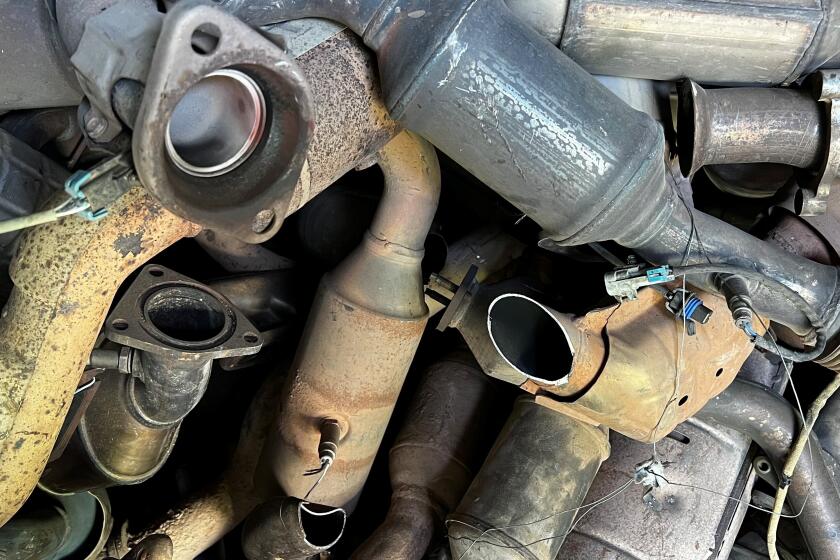Lethal Chemicals Routinely Trucked Through Urbanized Areas of County
- Share via
WASHINGTON — For several years the Air Force has been shipping cargo trucks filled with liquid cryogenic fluorine, a lethal chemical used for laser research, through some of the most heavily populated sections of Orange County.
Trucks carrying the hazardous chemical, the fumes from which could cause massive fatalities in an accidental spill, routinely roll down the 91, 55 and 5 freeways several times a year on their way to a TRW research laboratory on Avenida Pico in San Clemente.
The U.S. Transportation Department approved the route without explaining its decision. Although a major spill of the chemical could require the immediate evacuation of everyone within 3.9 miles, the government has done little to prepare local police and fire officials for such a catastrophe.
Dangerous as they are, the Orange County shipments are similar to thousands of other hazardous chemicals that are trucked over the nation’s roadways every day. Amid increasing concerns, a House subcommittee will open hearings this week on proposals to tighten controls on the practice.
Potentially Deadly Fuel
The following week, the hearings will move to Los Angeles, where officials are seeking to ban the shipment of potentially deadly rocket fuel that has been routinely trucked through the heavily populated San Fernando Valley to Vandenberg Air Force Base in Santa Barbara County.
The trucks headed for Orange County cross the state line over Highway 40, travel west on Interstate 15 to the 91 freeway, pass through Riverside to the 55 freeway, head across Anaheim and Orange to Interstate 5 and then head south through Santa Ana, Tustin and Irvine to San Clemente.
The Transportation Department is responsible for overseeing shipments of hazardous chemicals on the nation’s highways, but records show that thousands of toxic chemicals are trucked every day over major freeways without federal knowledge or control.
“It makes you wonder who is minding the store when it comes to the movement of such dangerous chemicals,” said Rep. Cardiss Collins (D-Ill.), whose House subcommittee will hold the hearings here and on Oct. 19 in Los Angeles.
Beyond a vaguely written 1939 federal statute urging drivers to avoid populated areas, there are no federal guidelines for truckers and chemical manufacturers. The majority of shippers are not required to tell government officials which routes they use.
Even when the Transportation Department has an opportunity to inspect and approve routes, there is little inclination to change them for safety purposes, said Fred Millar, a hazardous materials expert for the Environmental Policy Institute in Washington.
From Illinois to San Clemente
In the Orange County case, the Air Force needed special permission from federal regulators to ship liquid fluorine from an Illinois factory to San Clemente for laser research because it wanted to use larger containers than are usually permitted. The regulators required the Air Force to document the California freeways its shippers planned to use.
With little comment, Transportation Department officials approved the route from Highway 40 to San Clemente.
Federal officials said there have been no accidents since the shipments began nine years ago. They said the trucks used to transport the chemical have been reinforced and that the drivers are specially trained.
But in the event of a spill, the liquid fluorine could quickly vaporize, and people who breathed the gas could experience symptoms ranging from skin and eye burns, headaches and nausea to severe heart failure and death, according to federal studies. The federal government recommends that police and fire officials evacuate everyone within 3.9 miles of a spill.
Gary Girod, a Ventura County assistant fire marshal and an expert on hazardous materials transportation, has proposed that the fluorine instead be shipped through the desert by way of Beaumont, Hemet and Rancho California and then through Escondido and Oceanside. “This may be more circuitous,” Girod said, “but they’re good roads that pass through very few population centers.”
Taking Steps Toward Control
Federal officials, while acknowledging shortcomings in the way they regulate the highway transportation of hazardous materials, say they are taking steps to gain tighter control.
“We have an enviable record,” said Alan Roberts, who directs the Transportation Department’s hazardous transport section, “especially when you consider the billions of tons that are shipped on the freeways.”
With more than 426,000 trucks shipping chemicals over the nation’s highways, there have been 54 deaths reported nationwide in the past 10 years as a result of hazardous materials accidents. The number of incidents, ranging from major freeway spills to minor chemical releases, declined from 14,835 in 1977 to 4,546 last year.
But critics such as Rep. Henry A. Waxman (D-Los Angeles) say the Transportation Department has failed to adequately protect the public from the estimated 927 million tons of hazardous chemicals trucked annually. The Reagan Administration’s determination to deregulate the trucking industry, he charges, has left it unwilling to ensure the safety of shipments of hazardous chemicals.
Elsewhere, some state and local governments have passed their own restrictions. That, in turn, has led to a nationwide patchwork of confusing, parochial bans on chemical shipments that pit neighboring communities against each other and frequently trigger lawsuits from the trucking industry.
Department’s Powers
Congressional critics, private experts, local government officials, trucking industry leaders and chemical firms have urged that the Transportation Department more diligently enforce the 1975 Hazardous Materials Transport Act, which gave the department power to:
- Issue specific guidelines for local governments, chemical companies and trucking firms on the routes to be chosen for shipping dangerous chemicals.
- Develop a national data bank on the amounts of chemicals being transported over the highways, the firms that ship the materials and the routes they take.
- Help train local police and fire officials on the proper response to chemical spills.
None of these goals has been fully met, according to a 1986 report by the Office of Technology Assessment, a research arm of Congress. Researchers said Transportation Department officials have concentrated on developing tough regulations for the packaging of dangerous materials during shipment but concluded that far more had to be done to allay growing public concerns.
More to Read
Sign up for Essential California
The most important California stories and recommendations in your inbox every morning.
You may occasionally receive promotional content from the Los Angeles Times.










